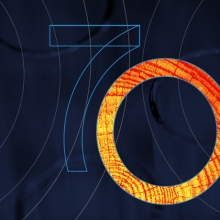Making the impossible possible
Dr. Ora Simcha Bitton Israel and her team are revolutionizing the way resources reach Weizmann scientists
Briefs

Of the 24 research departments at the Weizmann Institute, only one has the word “support” in its name: the Department of Chemical Research Support.
This unique department serves the entire Weizmann research community, providing scientists across all faculties with unrestricted access to highly advanced equipment and expert guidance. “My mission—since I joined the department 11 years ago—has been to increase the scope of the opportunities offered by my team,” says Dr. Ora Simcha Bitton Israel, the Scientific Head of the Department of Chemical Research Support’s Nanofabrication Unit—a state-of-the-art cleanroom facility for interdisciplinary research in nanoscience and applied nanotechnology.
“The work has been extremely rewarding. The scientists who come to us feel like we can make the impossible possible. If a researcher needs a resource or a material, so long as it is on the periodic table, we will figure out how to turn the scientist’s dream into a reality.” The steady flow of advanced materials and access to top-notch machinery are essential tools on the journey to scientific discovery, making the department integral to the success of Weizmann investigators.
Its 16 units offer tools and expertise in a wide range of methodologies, including electron microscopy, magnetic resonance imaging (MRI), X-ray diffractometry, ultrafast laser spectroscopy, organic synthesis, computational chemistry, and more. Dr. Bitton Israel’s Nanofabrication Unit is equipped with a full range of tools that support the fabrication and characterization of sub-micron devices and nanodevices.
As she explains, their work goes beyond simply providing resources; they collaborate directly with their Weizmann colleagues to formulate as strong a project as possible. With their bird’s eye view of the studies being conducted across campus, the members of the Department of Chemical Research Support can brainstorm comprehensively and suggest new approaches—which could have implications in multiple fields and offer the potential for interdisciplinary partnerships.
Start at the end
“Oftentimes, when a scientist approaches us with an idea for a project that would require specific materials or equipment, we strip the project down to its core goal and ask, ‘What is the scientific question this scientist hopes to answer? Is there another way to go about answering the question that has a broader scope?’ So, in a way, we start with the endpoint and work backward,” Dr. Bitton Israel says.
Once the project design is developed, the Chemical Research Support team works closely with the scientists and provides them with any training or resources they require. For example, Dr. Bitton Israel and her group recently worked with Weizmann physicists and chemists to create a novel design that dramatically increases the quality factor of plasmonic cavities—metallic nanostructures that confine electromagnetic radiation at the nanoscale, like trapping a beam of light between two parallel mirrors forever.
Conducted with other units in the department—the Electron Microscopy Unit, the X-Ray Photoelectron Spectroscopy Unit, and the X-Ray Diffraction Unit— this particular project illustrates how such collaboration can be a powerful tool. These days, Dr. Bitton Israel is looking to purchase a 3D printer for the direct printing of three-dimensional micro/ nanostructures—a cutting-edge instrument that would expand the scope of research groups across the fields of chemistry, physics, and life sciences.
“This groundbreaking technology will create entirely new avenues of scientific discovery in ways we cannot even imagine,” she notes, adding, “I am confident that this piece of equipment can impact the capabilities of Weizmann labs quite dramatically and be a real game changer.”
State of mind
The Department of Chemical Research Support will eventually relocate to the André Deloro Building for Advanced and Intelligent Materials that will house the Tom and Mary Beck Center for Advanced and Intelligent Materials (C-AIM), currently under construction. Dr. Bitton Israel has played an instrumental role in designing the building’s cleanrooms.
Cleanrooms typically adhere to one of two models: an open “ballroom” floorplan, with suspended plenums above and a separate floor below, or the “bay-and-chase” floorplan, which alternates between confined clean spaces (“bays”) and ventilation systems (“chases”). Each layout comes with its own set of trade-offs: while the ballroom model is more open, the bay-and-chase layout is easier to maintain. For the new C-AIM facility, Dr. Bitton Israel insisted on a novel design that combined the two models.
This first-of-its-kind design will include clean spaces that extend out from an open floor plan like fingers. “As a scientist, I wanted to work in a space that supported and reflected our state of mind, that didn’t feel cramped or confining; a facility that inspires creativity and new ideas,” she says. “But at the same time, we need separate specialized clean spaces. After much back-and-forth with the architects, we came up with a solution that I’m thrilled with.”
In addition to her responsibilities as Head of the Nanofabrication Unit, Dr. Bitton Israel is also a full-time staff scientist within the unit, currently collaborating with several research groups to develop sophisticated nanoscale devices. One of her areas of interest is the study of how photons communicate with matter—an investigation that could have important implications for quantum computing and information processing, as well as quantum optics.
“My parents instilled in me and my siblings a strong work ethic and a deep appreciation for excellence and professionalism,” Dr. Bitton Israel says. “It’s these values that drive me, both in the lab and as a Scientific Head at the Chemical Research Support Department. I am always trying to come up with new ways to push the Weizmann Institute to new heights.”








